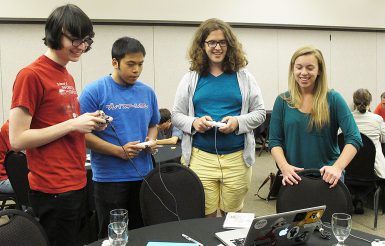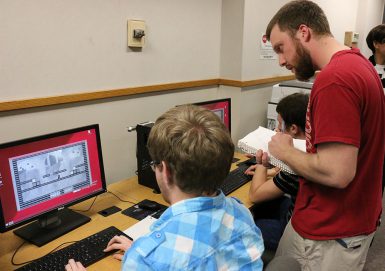New bachelor’s in game design will promote inclusive atmosphere
Game design: Another form of storytelling
Ted Castronova, Chair, Media Arts and Production
So my involvement with the game design Bachelor of Science degree is I’m the director. The program is designed around a student who wants to work in the game industry.
Video shows students working on games at computers.
OK so first and foremost, we want to make sure that our students know everything they need to become a leader in the game industry, so that means exposure to things like audio programming, digital art, you know, design, writing, business, all those things are covered. So we want a student who wants that set of skills. What you need coming in is a good work ethic, right, we don’t assume that people know any programming or that they’ve played a lot of games.
Students play games on computers in a lab.
We’ve had students making games in teams of like six to eight people, and these games have appeared on X-Box Live and on Kongregate. What’s cool about Indiana is that we are rock solid in all these other areas. We have a world-class music school, imagine combining game audio and training at the Jacobs School, the school of art, it just goes on and on. It’s just, it would be a wonderful place to to light your intellectual fire and really build an interesting career. What do you have to do? Come to Indiana. The door is open, just come and sign up. You know, we’re, we’re trying to create a culture that’s very open and friendly, so people who aren’t necessarily gamers, you know, can feel very confident.
Produced by Jonathan Goethals, BA ’15 Music by Bensound.com
The Media School’s new bachelor of science in game design degree will be inclusive to all genders.
That’s the message associate professor Edward Castronova, who helped design the degree, wants students and faculty to understand.
“There is every concern that the game industry is sexist, “ he said. “There’s the idea that the depictions of women in games are produced by ‘brogrammer culture.’”

With the advent of the new game design major, the IU Media School will be able to implement an inclusive culture from the start, he said.
“If you love games, and you want to make it your career, just come,” Castronova said. “Don’t hesitate. If you have a concern about ‘Can I do it?’ just come and try. We’ll make sure it’s a friendly atmosphere.”
Classes in game design had been offered through the telecommunications department, with Castronova leading the program. When the department merged with journalism and film studies to form The Media School last year, Castronova saw a way to offer a bachelor’s degree – and to extend that “friendly atmosphere” he had been working on in the department.
Castronova’s own research has examined the problem of a male-centric game culture. He said this begins before students reach college age.
“I think the core reason for disparity begins around age 12,” he explained. “The research I’ve seen indicates boys and girls start seeing the world in a different way. It shows up not in whether they play, but what kind of games they play and what their interest level is. What we inherit are these cultural assumptions that I think can be changed. “
“What we have to do is fight against some cultural assumption that women are not aggressive or strategic.”
Sophomore Amy Shedd, an informatics major planning to add a game design major as well, defies that stereotype. Shedd grew up playing video games and, as a female game designer, she can pave the way for other women, she said.
At first she was nervous about the proportion of guys in her classes, she remembers, but quickly put that worry to rest.
“There is a lot stigma in the video game industry toward women,” she said. “All the teachers that I’ve had for video game or game design classes have been have super nice about girls being in the class. They treated me just like all of the guys.”
Castronova and the game design core faculty — professor of practice Mike Sellers, lecturer Will Emigh and lecturer Norbert Herbert — are taking the initiative to create a gender-equal environment.
Shedd said in her classes with Sellers, he asks for a female and male perspective. He taught without any bias, she emphasized.
“We believe that game design doesn’t have to be a guy-oriented thing,” Castronova said, explaining that he wants female students to feel comfortable in the classroom without being highlighted. “What they really seem to want is gender to evaporate. They want it to not be marked. “
One of his first intentions is to hire female faculty. He also hopes to hire female designers-in-residence, who will mentor male and female students.

The game design core faculty conducted a focus group last May with the help of IU’s Center on Women in Technology to hear the thoughts of about 30 women interested in game design and technology.
“I think most women who are working in these kind of areas just assume that it will be somewhere between OK to hostile,” Castronova said. “I think our primary job is to move away from a type A guy communication style.”
The women in the current game design classes and the club Hoosier Games represent a high proportion of leaders, Castronova said.
“The women that we do have will be leaders,” he said of the new degree program.
Glenna Read is a doctoral student in The Media School whose research deals with the depictions of women in video games. Read helped host a luncheon with potential female game design students to hear their thoughts.
“I think that one of the barriers for women enrolling in game design courses is that they just don’t think that they would fit in,” she said.
Having more women design games may change the way women are presented in games, she explained.
“A big problem with the representation of women in video games is sexualization, “ she said. “Women are not depicted as main characters and, when they are depicted, they are shown in ridiculous ways, scantily clad women and with certain body parts emphasized. The way women are represented in video games does have repercussions.”
Graduate student Christopher Ingerson is pursuing a master’s of science, focusing on game development. He also was a teaching assistant for Sellers’ Video Game Industry course. The class had only a handful of women, he explained.
“But just in the past year, we have seen a pretty big spike in women,” he said of the game design courses. “It’s definitely a number that is slowly increasing.”

He said the game design courses are challenging for students of both genders because of the nature of work.
“It’s not on her to prove herself as a female designer or female programmer; it’s on her to prove herself as a game designer or programmer,” he said.
IU’s game design professors have worked hard to promote equality among female students, Read added.
“They have done a really great job of being supportive of them without alienating them,“ she said.
Shedd said she is excited to professionally pursue her childhood interest in gaming.
“Ever since I was little, I just loved video games,” she said. “Now I actually have a chance to learn how games were designed. I remember being 10 and playing video games. When I get out of college and get a job in the game industry, I hope 10-year-old girls will be playing the games I’ve worked on.“
Castronova said The Media School program may not be able to change the entire mindset of the gaming industry, but it’s a start.
“I’m an educator, and I think games are cool, and I know that both boys and girls like games,” Castronova said. “Let’s do what we can at the college level and contribute to solving the problem.”
More:

